MARIANI’S
Virtual Gourmet
February
17, 2019
NEWSLETTER
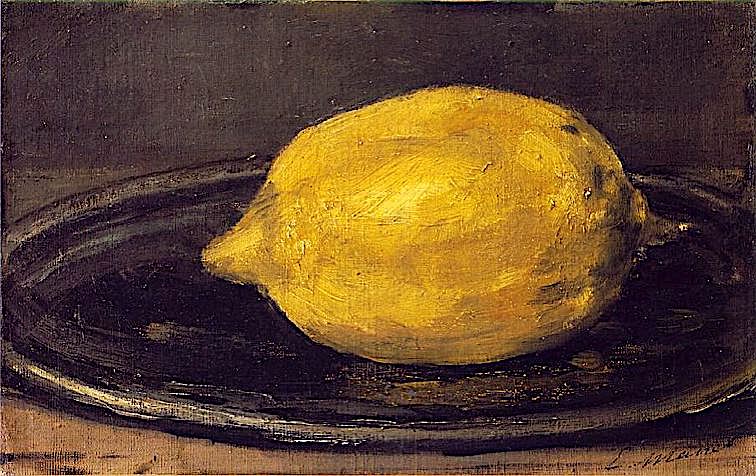
❖❖❖
IN THIS ISSUE
NEVER A BETTER TIME TO
DINE OUT IN MADRID
By John Mariani
NEW YORK CORNER
TORIKO
By John Mariani
NOTES FROM THE WINE CELLAR
WHAT I'M DRINKING NOW
By John Mariani
❖❖❖
NEVER A BETTER TIME TO
DINE OUT IN MADRID
By John Mariani
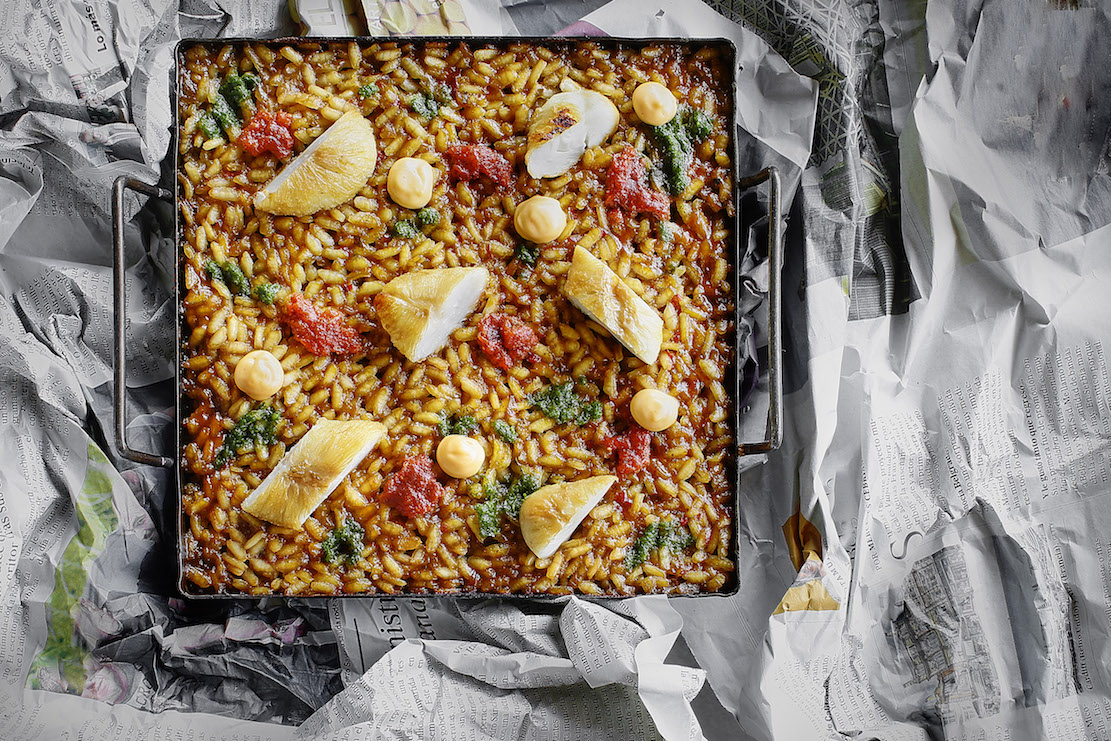
(By the way, while tax and service are usually included in Madrid’s restaurantes, the old bread-and-butter charge is still in place.)
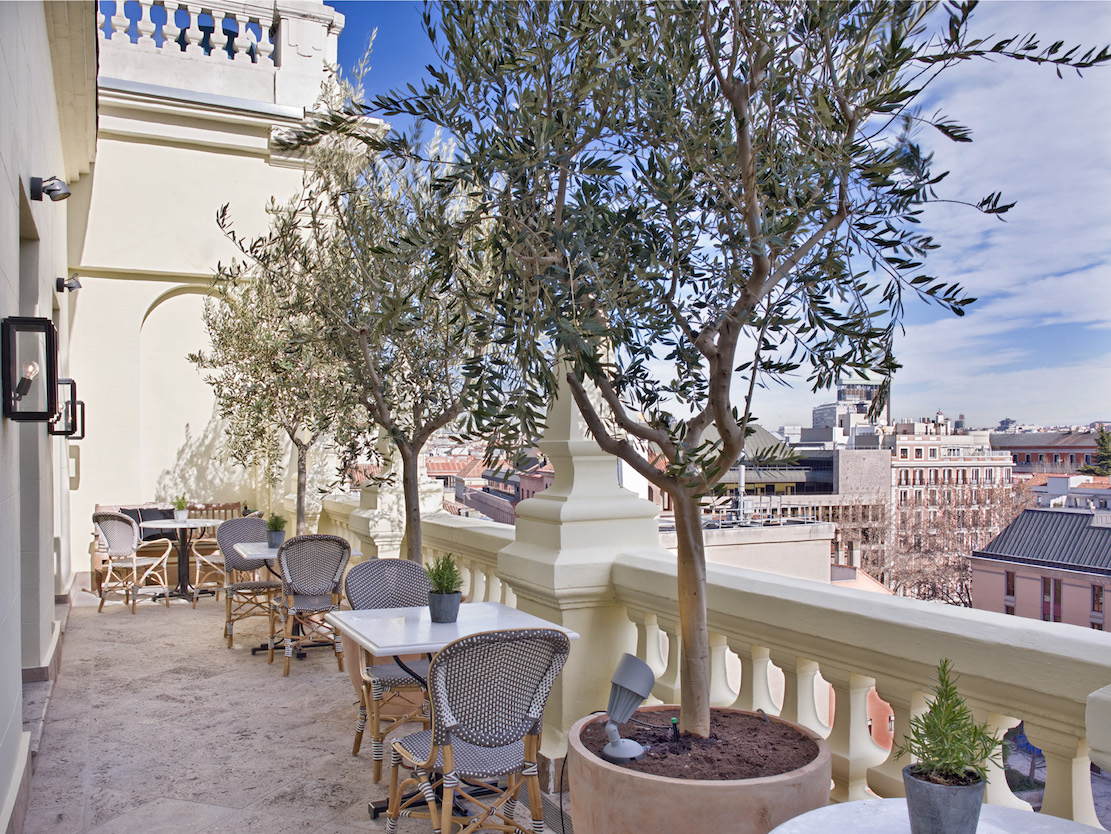 ATICO
ATICO
Principal
Hotel
Calle
Marqués de Valdeiglesias 1
91 532 94 96
The
pleasantly quiet,
77-room Principal Hotel, across from the historic
Metrópolis building and just
a block from The Prado and Thyssen-Bornemisza
museums, has snared one of
Spain’s most illustrious young star chefs, Ramón Freixa, who is also chef
at
the Unico Hotel in Salamanca. His dining room
Atico has already won high
accolades it well deserves.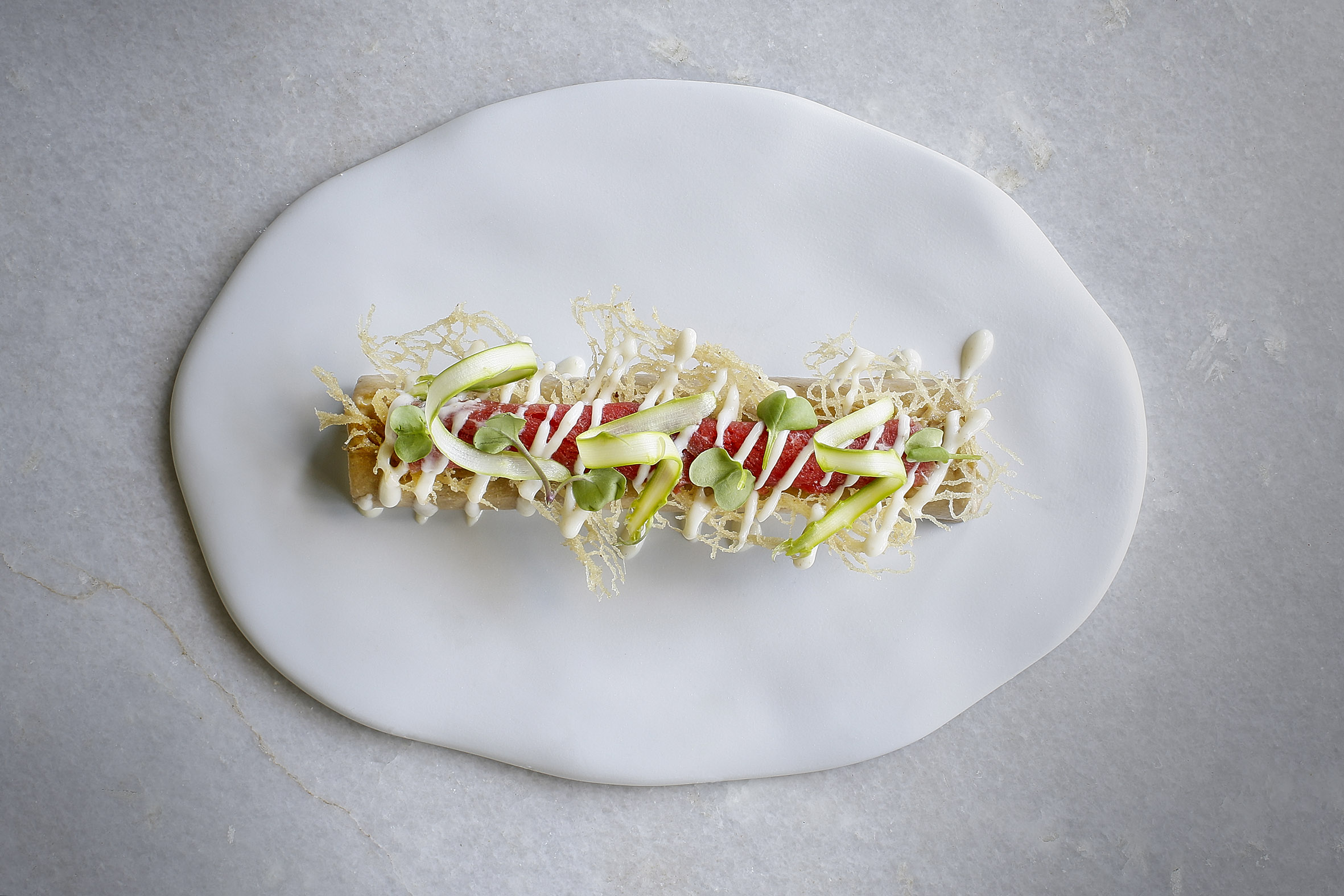
The swank dining room and
outdoor terrace,
which at night is a starry vantage point to watch
the city move and shift,
seats 70, and there is also a charming cocktail
lounge where you might begin
your evening with a glass of cava.
The wine list is not large but impeccably
chosen to show the best in
Spanish viniculture in this century.
Sitting outside on a clear
autumn evening, my
wife and I chose the €70 menu of six courses (with
€24 for wine pairings),
which began with a kind of surf & turf of
octopus with Peruvian purple
potatoes and a curry-scented 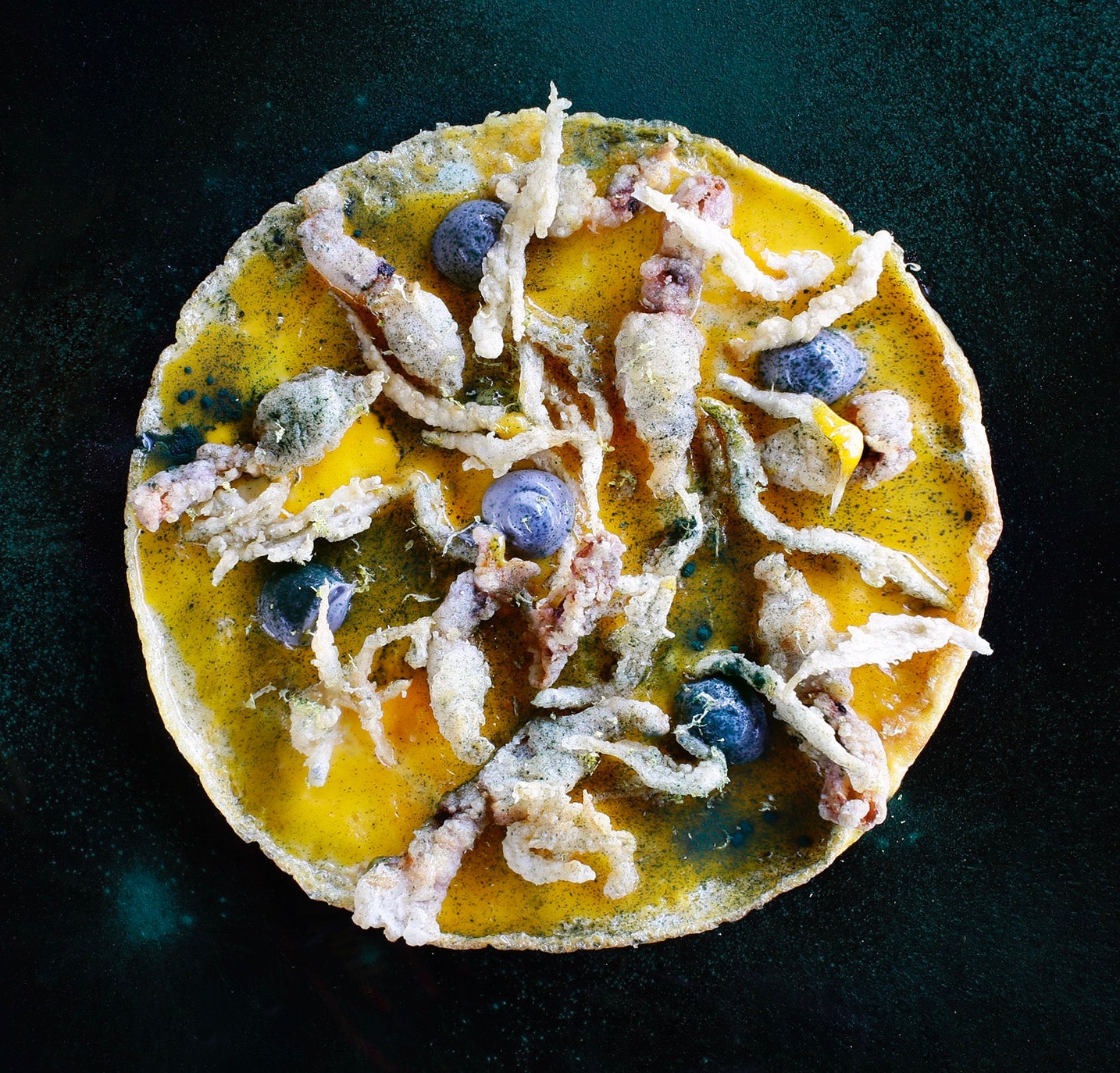 mojo on
top. Next
was cannelloni with
black truffles and a carpaccio of beef with what
resembled a Mexican mole.
Grilled sea bass came lightly
sweetened with mango, sided with saline marine
algae and a quinoa salad spiked
with a dose of ginger.
mojo on
top. Next
was cannelloni with
black truffles and a carpaccio of beef with what
resembled a Mexican mole.
Grilled sea bass came lightly
sweetened with mango, sided with saline marine
algae and a quinoa salad spiked
with a dose of ginger.
For dessert Freixa served a
lovely version of
liquid dulce
de leche coffee caramel
with lollipop cakes dusted with sea salt.
Each of these dishes referenced
Spain’s
involvement in the global spice market and paid
homage to the food cultures of
lands Spain once held. This was very beautiful,
subtly refined cuisine, and,
with glasses of contemporary Spanish wine, it all
fit seamlessly into our first
night in Madrid.
Lunch menu at €45; dinner €70.
Open daily for breakfast, lunch and dinner.
RESTAURANTE
PALACIO CIBELES
Plaza
de Cibeles 1
91-523-1570
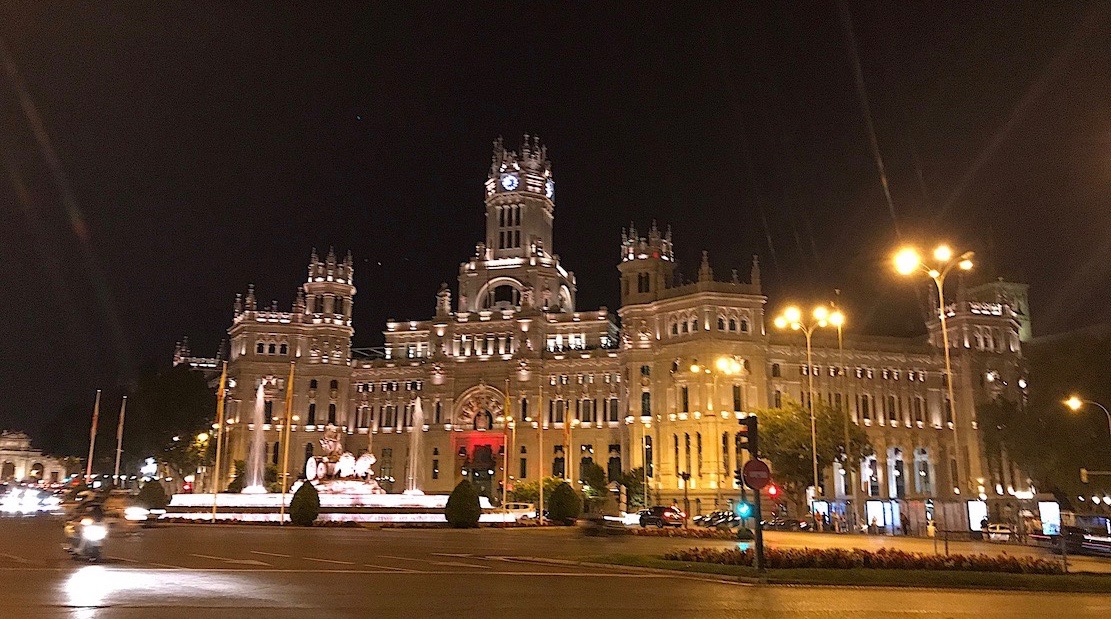
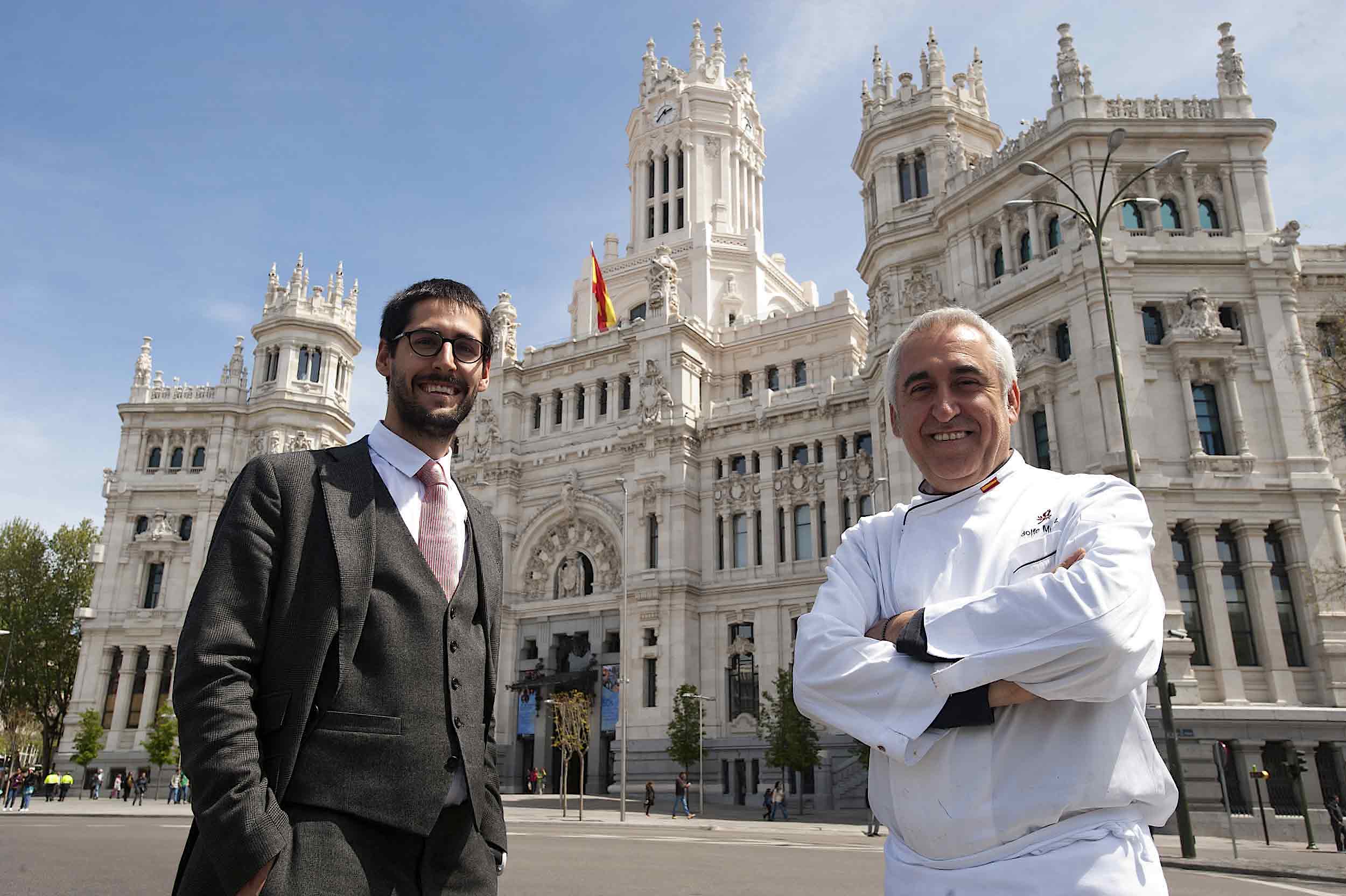 Adolfo and
his son Javier (left)
also have a tapas
place in Madrid called Colección Cibeles, a
restaurant in Toledo (which I shall
be writing about in the future), a new boutique
hotel and a winery. Here, with
seating inside for 100 and more on two terraces,
their restaurante is on the sixth floor of
what was formerly the
Communications Palace, now Madrid’s City Hall. It
is an ornate 20th century
edifice that arcs around the Cibeles Plaza,
looking up towards the Grand Via.
By tradition, when the soccer team Real Madrid
wins a game, fans flock to the
Fountain of Cibeles to celebrate. Inside the
building are municipal offices as
well as CentroCentro exhibition hall and the Glass
Gallery.
Adolfo and
his son Javier (left)
also have a tapas
place in Madrid called Colección Cibeles, a
restaurant in Toledo (which I shall
be writing about in the future), a new boutique
hotel and a winery. Here, with
seating inside for 100 and more on two terraces,
their restaurante is on the sixth floor of
what was formerly the
Communications Palace, now Madrid’s City Hall. It
is an ornate 20th century
edifice that arcs around the Cibeles Plaza,
looking up towards the Grand Via.
By tradition, when the soccer team Real Madrid
wins a game, fans flock to the
Fountain of Cibeles to celebrate. Inside the
building are municipal offices as
well as CentroCentro exhibition hall and the Glass
Gallery.
At the restaurant there are set
menus at €38.50,
but we put ourselves in Javier’s hands for a more
extensive sampling at €59.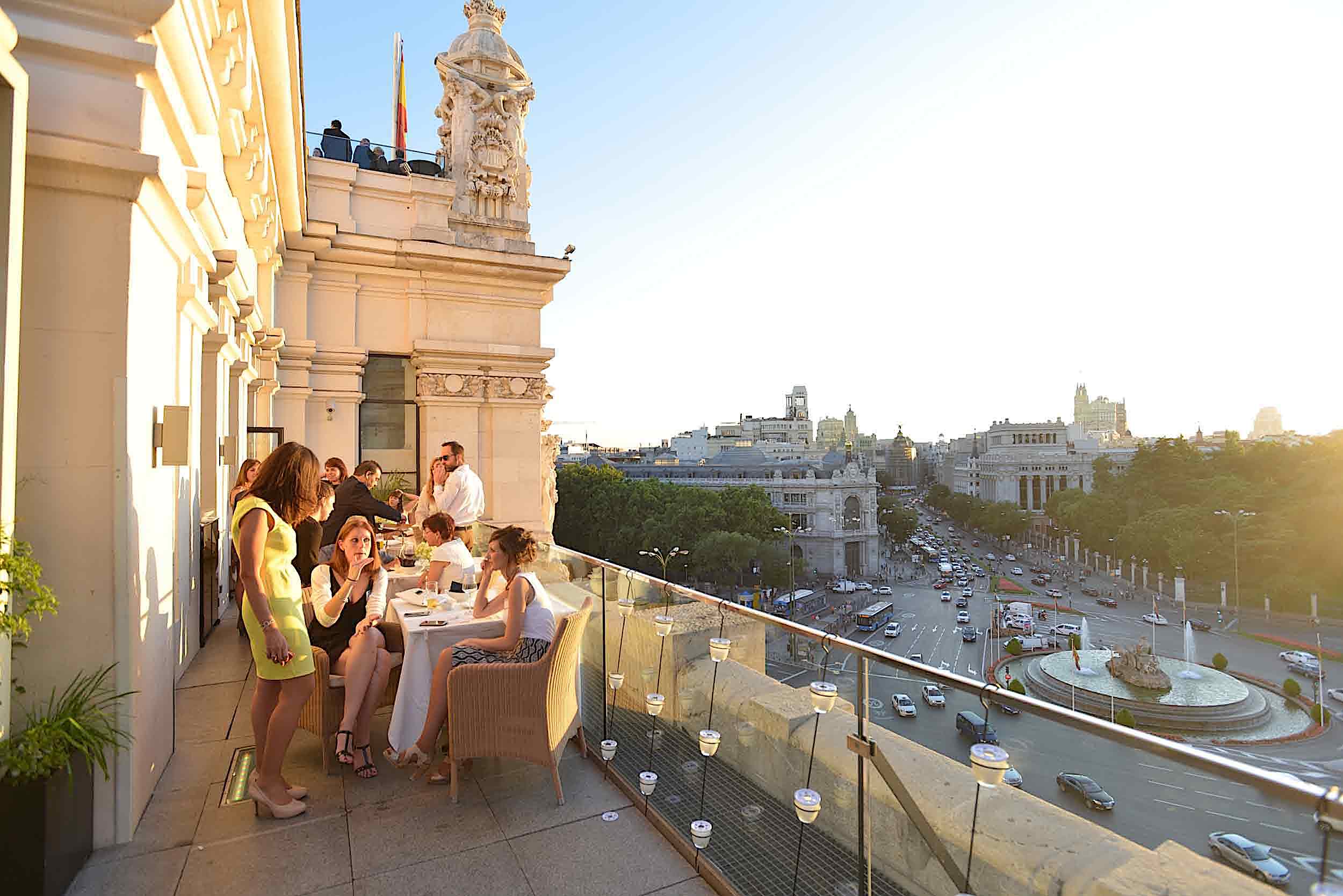
Javier, 36, a wiry, bearded fellow
who reminds
me of a Dominican figure from an El Greco
painting, says that he is “making my
grandmother’s food,” but either his grandmother
was a very sophisticated cook
or Javier has taken a great deal of leeway with
the family recipes. What he
meant was that he does not stray into eccentricity
with his cooking, basing
everything on the freshest local ingredients—the
Madrid fish market, located
twenty minutes away, is the largest outside of
Tokyo —and he adds no salt to
his seafood. The foie gras comes from Extremadura,
and the figs come from his
family’s farm.
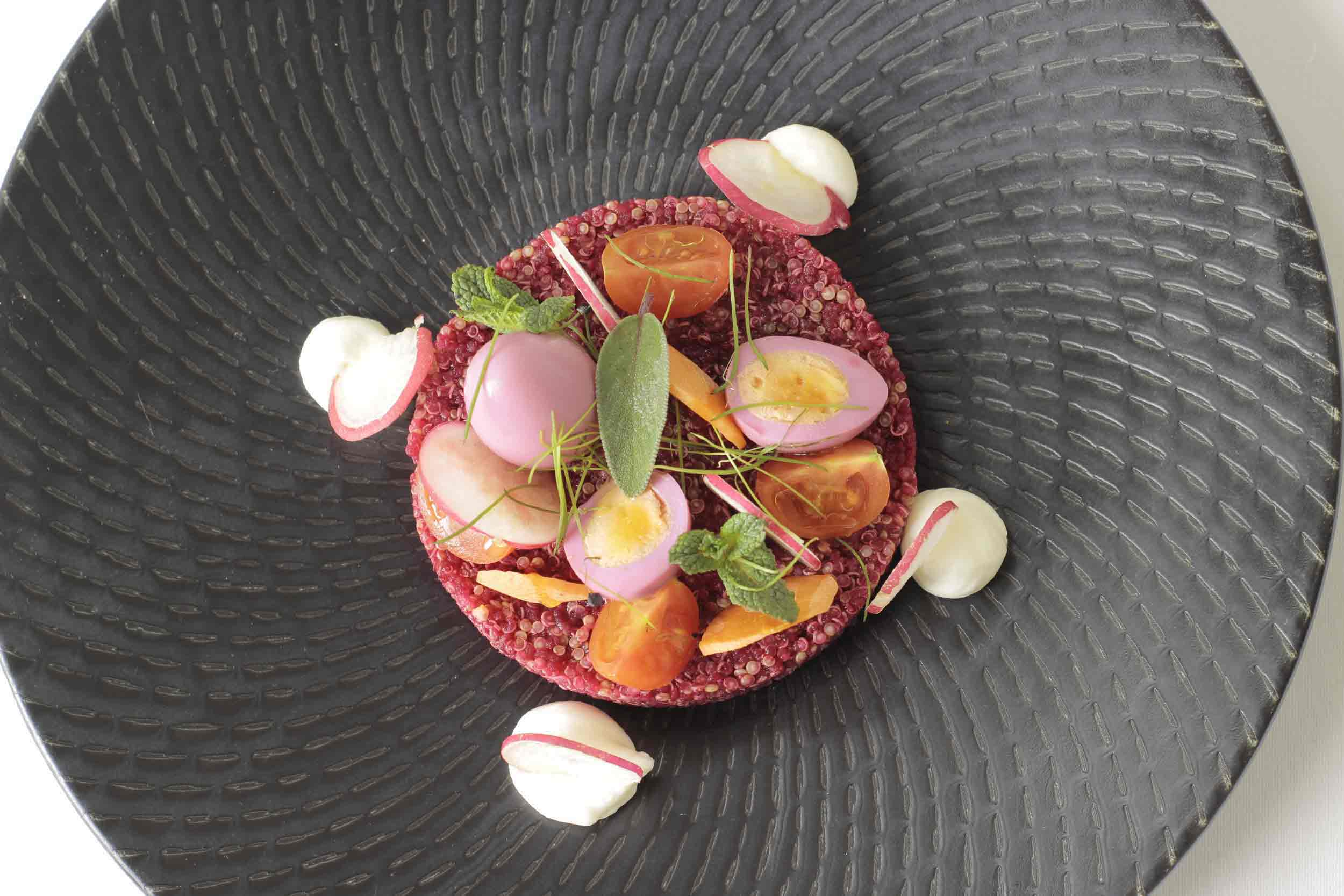 He began by
serving us canapés of zucchini
flowers and dried beet chips to nibble while we
sipped a gin cocktail Javier
suggested. Next came a ceviche of shrimp, mussels,
clams, tuna and marinated
salmon with red onion, using the
shell liquid as its base. Cod came carefully
steamed with a sauce of roasted
pimiento topped with tobiko eggs.
He began by
serving us canapés of zucchini
flowers and dried beet chips to nibble while we
sipped a gin cocktail Javier
suggested. Next came a ceviche of shrimp, mussels,
clams, tuna and marinated
salmon with red onion, using the
shell liquid as its base. Cod came carefully
steamed with a sauce of roasted
pimiento topped with tobiko eggs.
Another wonderfully flavorful
fish was turbot
grilled over paper, then finished under a
salamander with soy, sunflowers and
just a touch of honey to give a sweet note. Two
meat courses followed. Venison
was cooked in red wine for 24
hours, so it was fork tender, served with a
chutney of apricot and figs, while
very moist, creamy-textured suckling pig,
beautifully presented after roasting
at a low temperature for five hours, had a crisp
skin and a nice smoky flavor
that did not compromise the essential taste of the
pig. It came with a confit
of peppers and Lyonnaise-style potatoes.
To end this remarkable evening
we enjoyed
orange ice cream with chocolate sticks in the
style of Parisian chef Cedric
Grolet.
Below us
in the plaza, car headlights raced in
firefly patterns, while up the Gran Via the
buildings gave us a
shadow-and-light show against the dark foliage of
the Retiro Park. But even
late in the evening, the sounds of the city gave
the scene a unique vitality
that would go on for hours more.
❖❖❖
By John Mariani
TORIKO
76 Carmine Street (near Clarkson Street)
646-596-8198
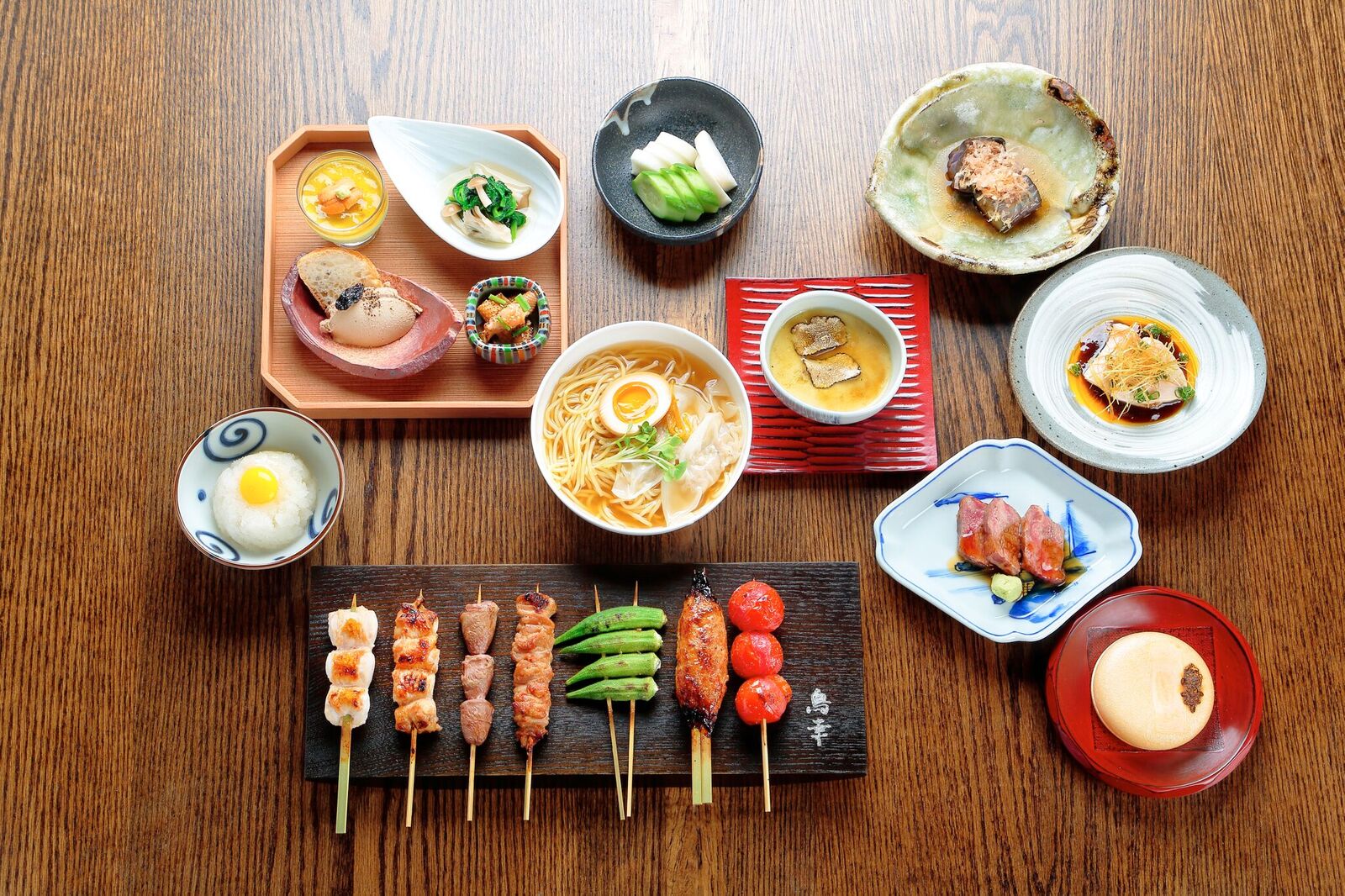
Just as Americans go
out for burgers and
Chinese for dim sum, Japanese more often
than not choose a place to eat
depending on what they feel like
eating,
hence the ubiquitous array of counter
eateries devoted to one style of
cuisine—sushi, unagi,
fugu, tempura, tonkatsu,
kushiage, nabemono, teppanyaki,
ramen and yakitori.
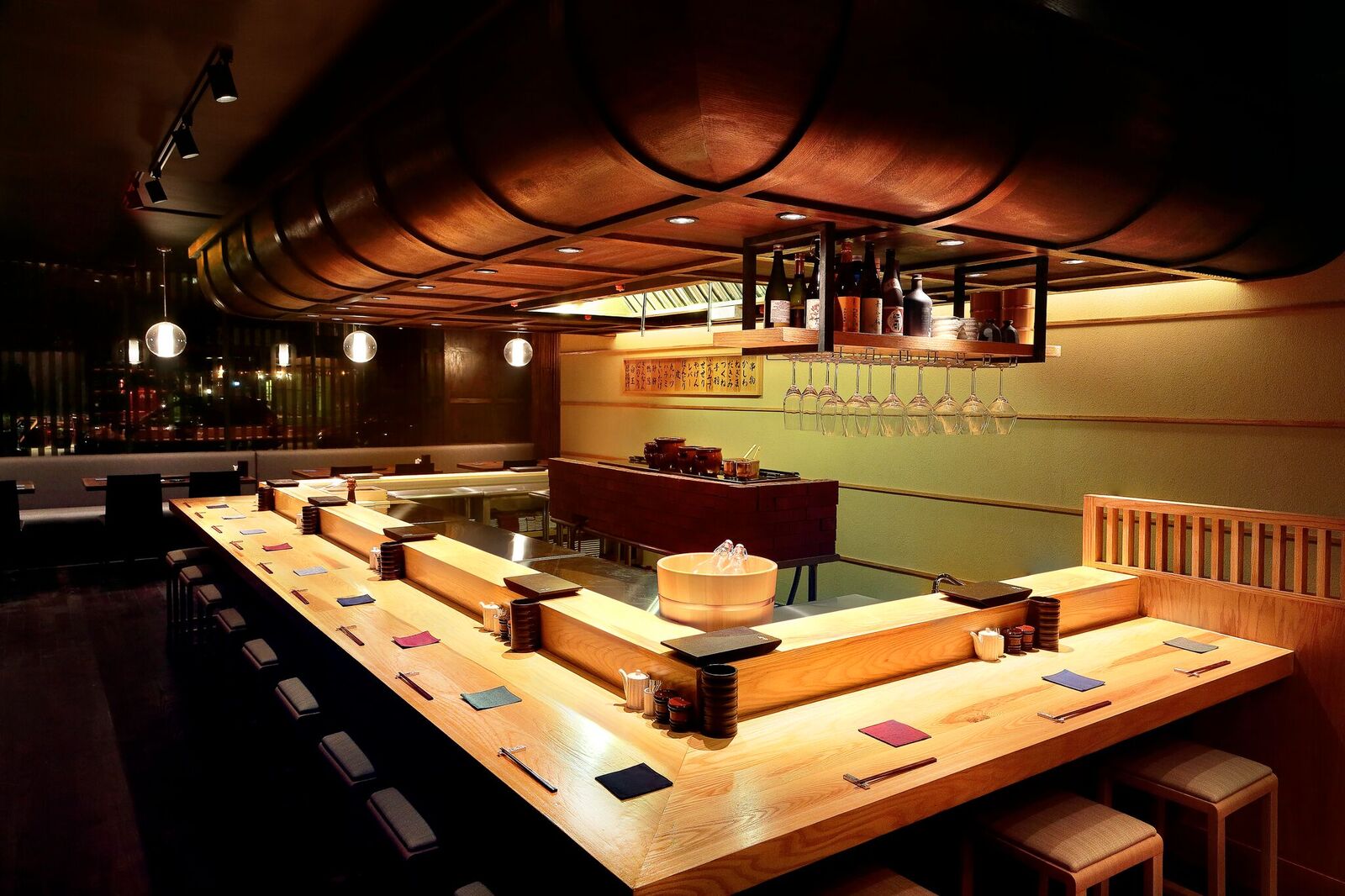 To this last style of
cooking—chicken on
skewers over charcoal—belongs Toriko in Greenwich
Village, the first outlet of
a chain named Tokyo Restaurant Factory, which also
runs Mifune and Amane in New
York. In Tokyo and Osaka there are a dozen
Torikos, but this is their first in
the States.
To this last style of
cooking—chicken on
skewers over charcoal—belongs Toriko in Greenwich
Village, the first outlet of
a chain named Tokyo Restaurant Factory, which also
runs Mifune and Amane in New
York. In Tokyo and Osaka there are a dozen
Torikos, but this is their first in
the States.
The darkened door of the
restaurant opens onto
a small, colorfully lighted bar counter, then to
the right is the main dining
room, together seating 46 people, most of them
choosing the counters, with a
few two-person tables set around the room. The décor is highly typical
in its minimalism: beautiful
caramel-colored, polished woodwork and an open
kitchen space where one cook
puts dishes together and behind him the grill chef
stands stolidly turning his
wooden skewers over a charcoal grill. The
Executive Chef is Shinji Odahara, a
veteran of the Nadaman group in Japan and now Food
Director of the Toriko
brand.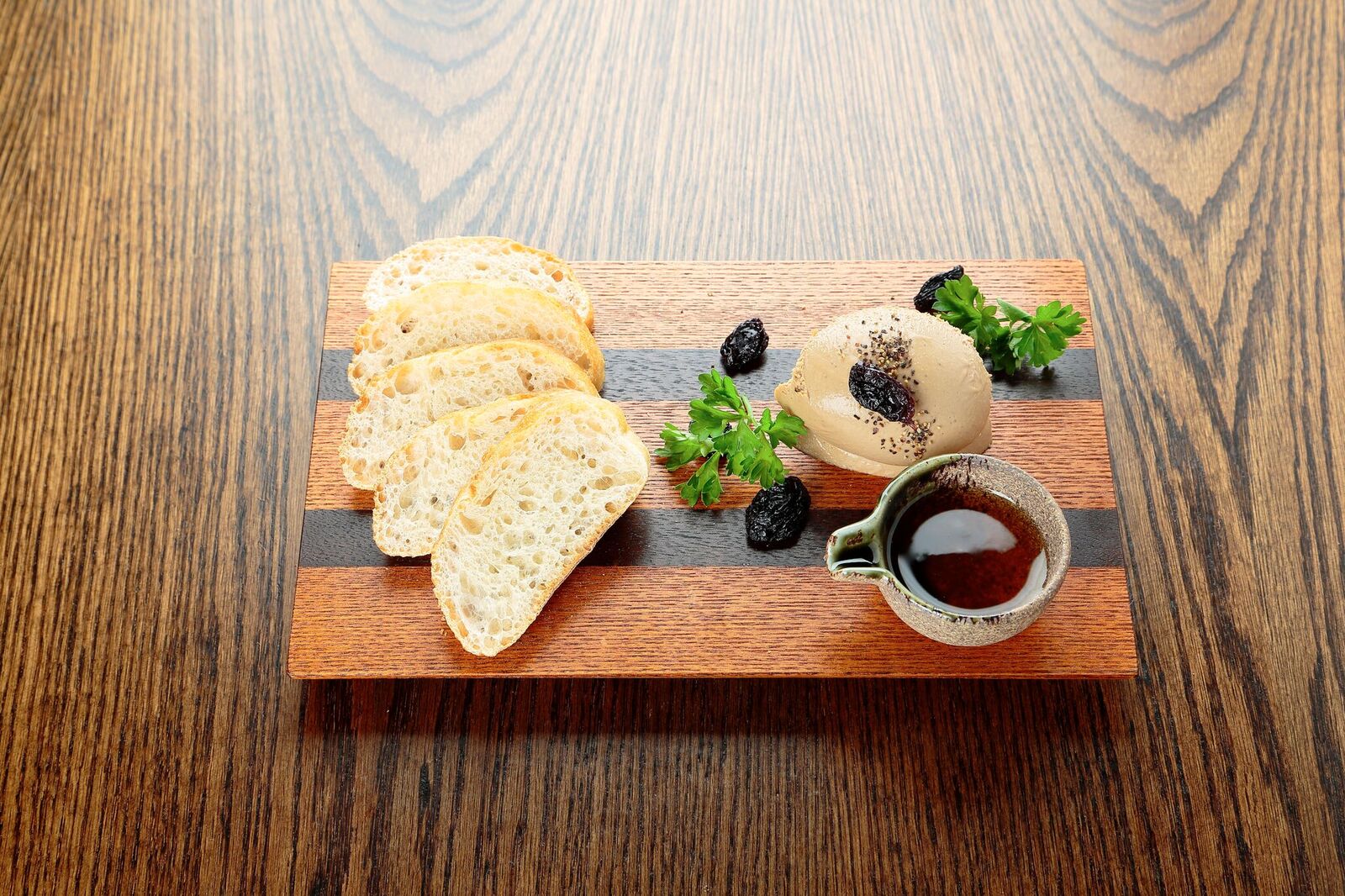
Although not
strictly an izakaya pub, the tradition of
serving several courses over an evening is the
motif here,
but the pacing seems faster than is often the case
in Japan, where a good
deal of sake and beer drinking is part of a long
evening out. When we dined
there, courses came out the moment the dishes for
the last were picked up by
the affable crew.
There is a very good sake list,
several
specialty cocktails, a reasonable number of wines,
some local and international
brews but only four Japanese beers. The one to try
is the akanigori red beer with delightful
spicy notes.
Yakitori dominates the menu and
the technique
depends on split-second timing to retain the
juiciness of the meat, mostly
chicken, with just a slight searing on the
outside. The chicken itself needs to
be sourced carefully. The skewers
come with shio
sea salt, tare soy
sauce and freshly grated
wasabi, which you sprinkle on the meats.
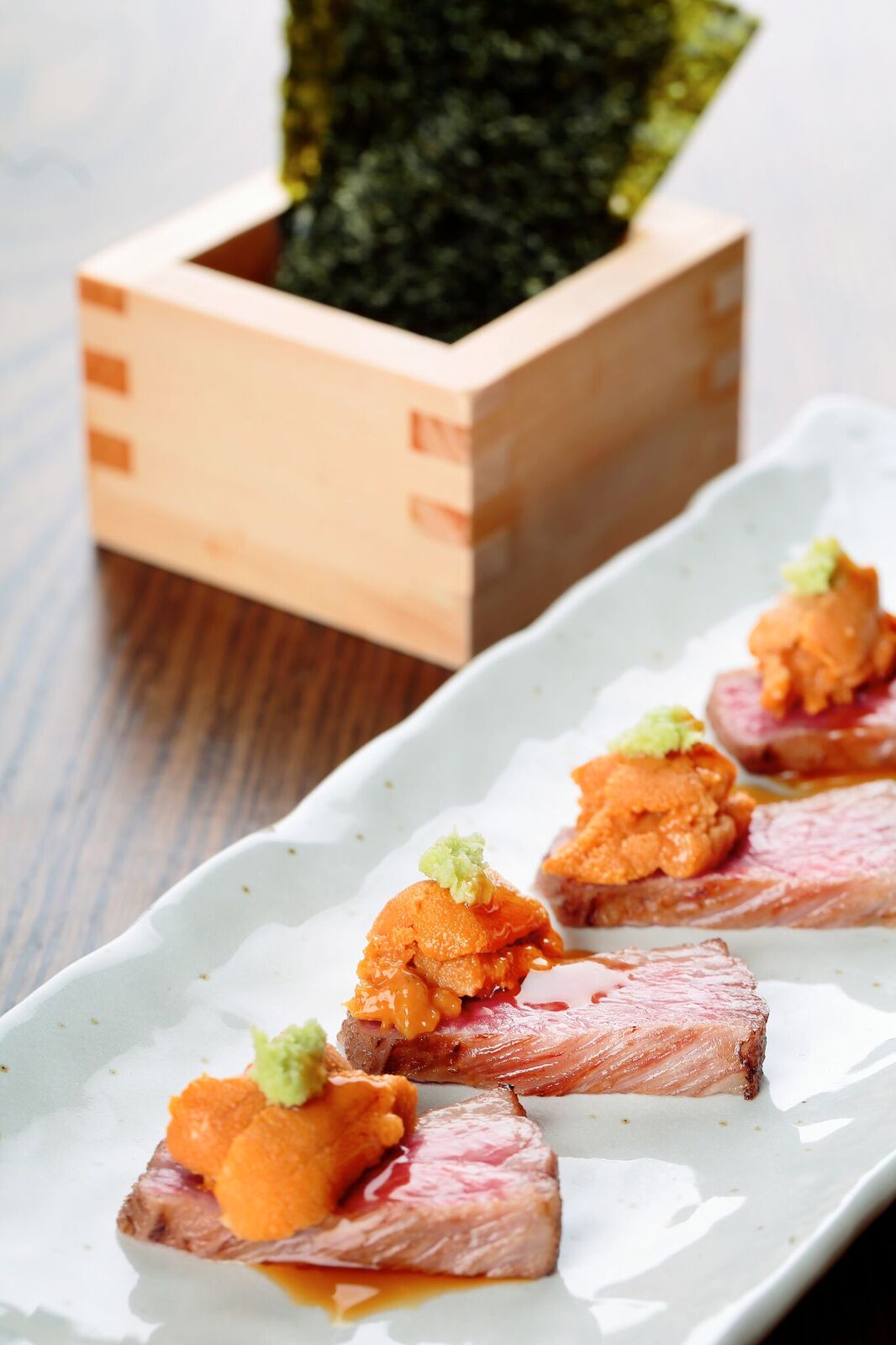 There are two set menus
available, at $70 for
four courses and $85 for seven, plus à la carte. Since portions are small and
none of the food is heavy, it’s
easy to go with seven-course meal and not feel
stuffed at the end.
There are two set menus
available, at $70 for
four courses and $85 for seven, plus à la carte. Since portions are small and
none of the food is heavy, it’s
easy to go with seven-course meal and not feel
stuffed at the end.
You begin with five small bites
on one plate,
which vary seasonally. This is followed by a scoop
of creamy chicken
foie gras chawavmushi
with truffles,
and then a small bowl of refreshing pickled
vegetables.
Then come the yakitori in
flights: five of
chicken on skewers, including chicken oysters,
very tender, very moist; two
vegetable skewers, which included lovely maitake
mushrooms and cherry tomatoes with zucchini, as
well as an interesting ice cold
snowy ball of shredded turnip. Some very welcome tsukune meat balls added some heft
to the meal, then cheese, and an
even more welcome dish of sliced Japanese wagyu,
whose fatty richness seemed by then like a reward
for eating all that led up to
it (left).
Sunagimo was
a skewer of marihatsu
chicken hearts, rather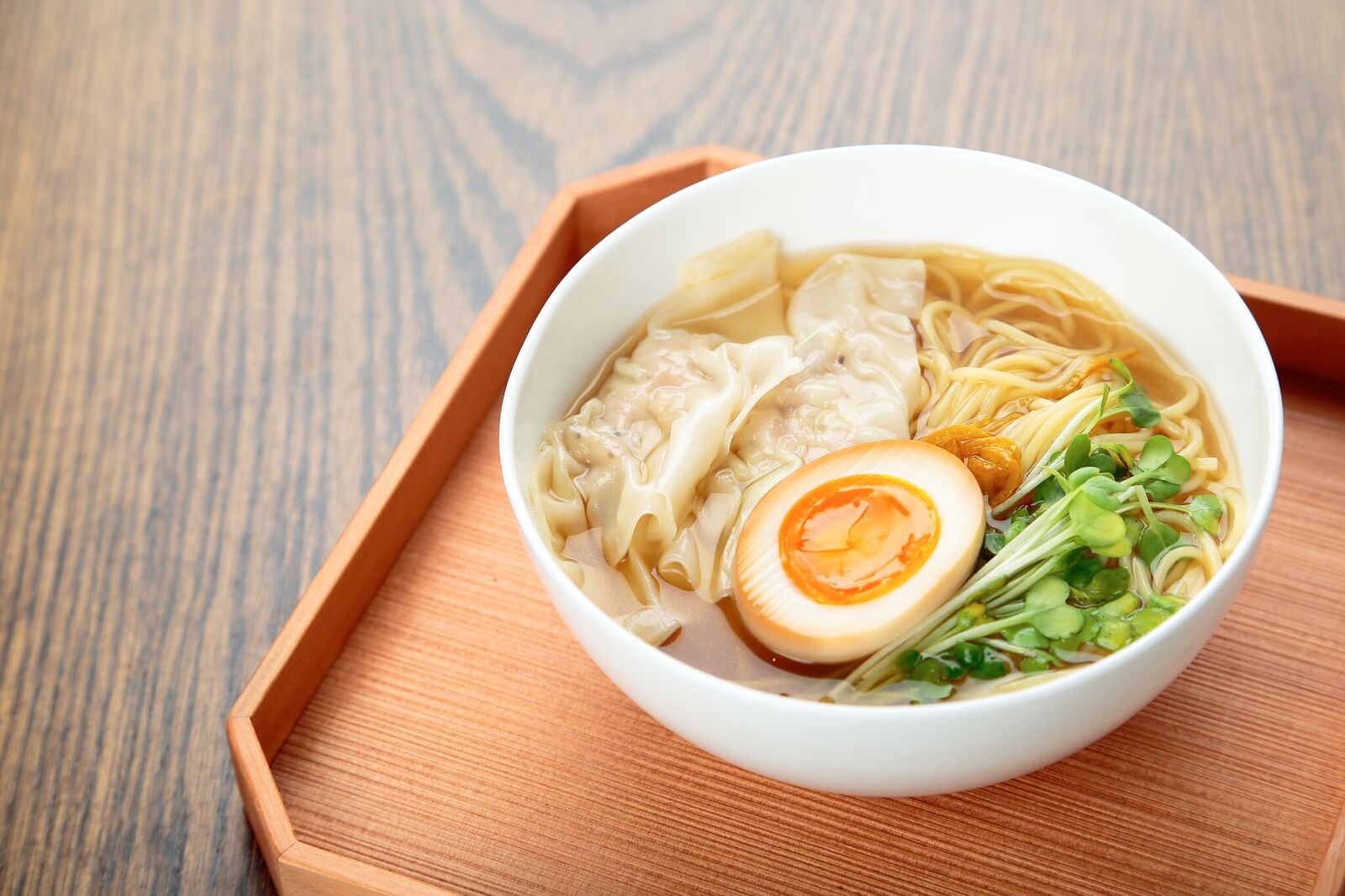 mild in
taste.
mild in
taste.
The savory meal
finished off with a salad and a
choice of either oyako don chicken
and
egg (hard to tell which came first) in a rice
bowl, or a shio
ramen of silky, tender noodles in a
rich broth (right).
I can’t say the desserts of
Japanese ice cream
and matcha
mousse were memorable.
It
must be noted that this kind of food hasn’t
the intensity some might have come to expect if
they’ve been used to chili pepper-laced
dragon rolls or caviar-topped sushi. The flavors
are really quite subtle,
despite the shaved wasabi, and since izakayas in
Japan are regarded more like
pubs, the food at Toriko is akin to going to a
Spanish tapas bar.
It’s a charming experience and a
well-wrought, well-priced option.
By John Mariani
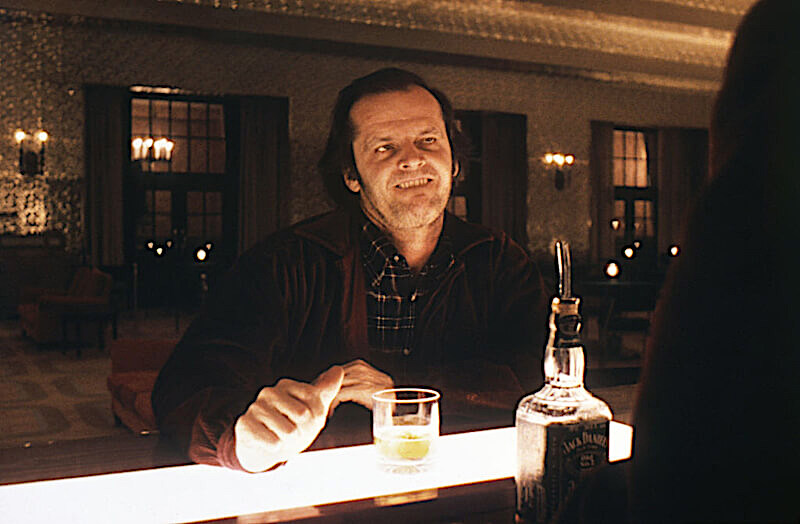
The February blahs—cold weather, no football or baseball, TV reruns, movies dumped by Hollywood—are a very good reason to drink red wines that I haven’t tasted in a while in order to assess my current ideas about them. Here are some that impressed me.
MAISON
ROCHE DE BELLENE CHAMBOLLE-MUSIGNY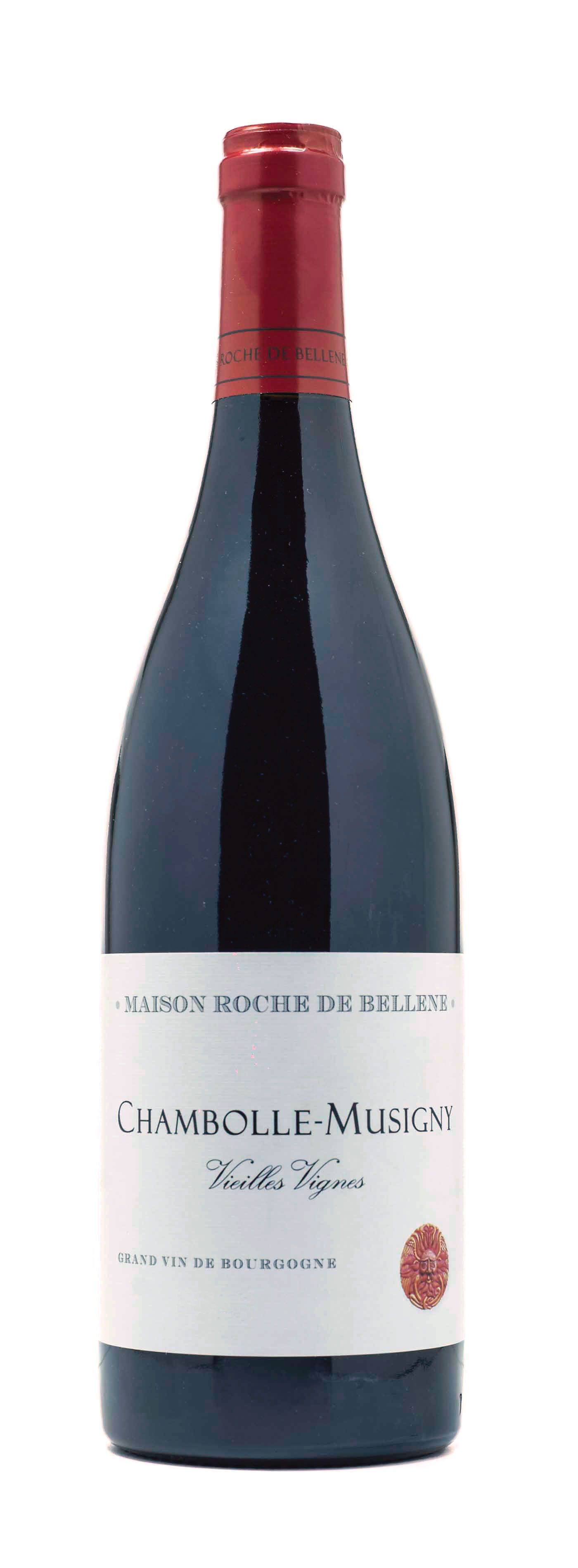 2011 ($80)—If you wish to taste two
distinctly different but admirable examples
of French versus California Pinot
Noirs, this “old vines” Burgundy and the
Masút from Mendocino below provide for
a good lesson. Maison Roche de Bellene is a
negoçiant
(merchant), not a grower, and buys from
many of the best vignerons in
Chambolle-Musigny, whose wines, if lighter
than Vosne-Romanée, have wonderful
fragrance and, given eight years of age like
this one, they have settled into
exquisite balance at 13% alcohol.
2011 ($80)—If you wish to taste two
distinctly different but admirable examples
of French versus California Pinot
Noirs, this “old vines” Burgundy and the
Masút from Mendocino below provide for
a good lesson. Maison Roche de Bellene is a
negoçiant
(merchant), not a grower, and buys from
many of the best vignerons in
Chambolle-Musigny, whose wines, if lighter
than Vosne-Romanée, have wonderful
fragrance and, given eight years of age like
this one, they have settled into
exquisite balance at 13% alcohol.
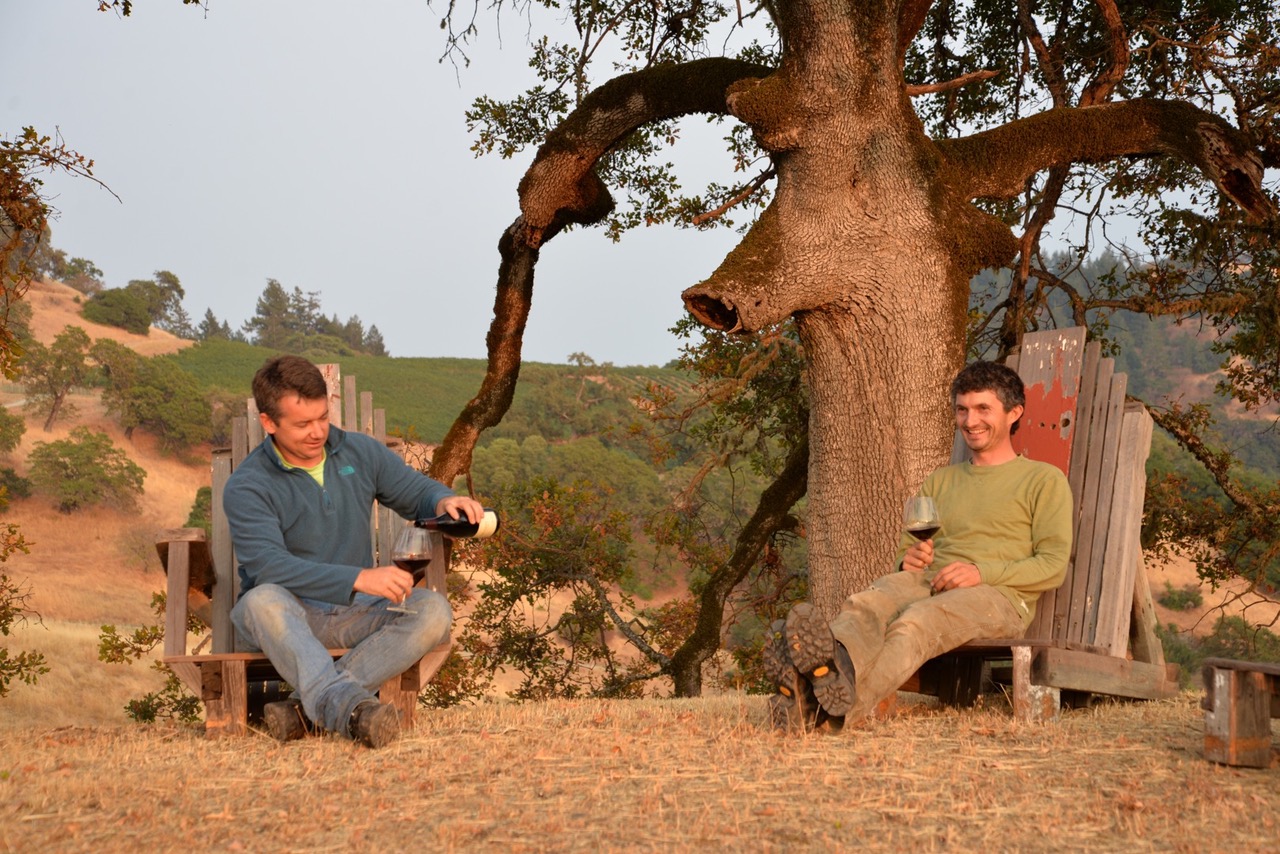
MASÚT
PINOT NOIR ESTATE VINEYARD 2016
($40)—Ben and Jake Fetzer (left),
grandsons of Barney Fetzer of Fetzer
Vineyards, founded Masút Vineyard and Winery
in Mendocino County to be Pinot
Noir specific. Using five clones, planted in
35 acres of “dark, rich earth,”
they’ve made a sumptuous but not plummy
Pinot Noir, with 14.5% alcohol, that
retains the flavor of the varietal and adds
a boost of California power.
CHÂTEAU
SMITH HAUT LAFITTTE 2001 ($125)—A
Grand Cru Classé Graves of Pessac-Léognan,
the chateau dates back to the 14th century.
Florence and Daniel Cathiard have
owned it since 1990 and brought to bear
modern viticulture to every aspect of
the estate, spending three years restoring a
vineyard once called “Sleeping
Beauty.”
Their modus operandi, as explained by
Florence, is that “Agriculture contains the
word culture, artisan contains the
word art, and aesthetic is similar to
ethical.” That kind of breeding shows the
vibrancy and depth of the wines of the
Graves region along with a layered
delicacy that flows throughout the palate.
NORTHGATE
VINEYARD PETIT VERDOT 2015
($32)—Petit Verdot is usually an element in
Cabernet Sauvignon blends and not
often seen as a single varietal outside of
Bordeaux. North Gate, located in
Virginia’s Loudon County, shows how charming
the wine can be and how much body
it can have, with plenty of spicy,
cedar-like notes. Very good with chicken or
ham. 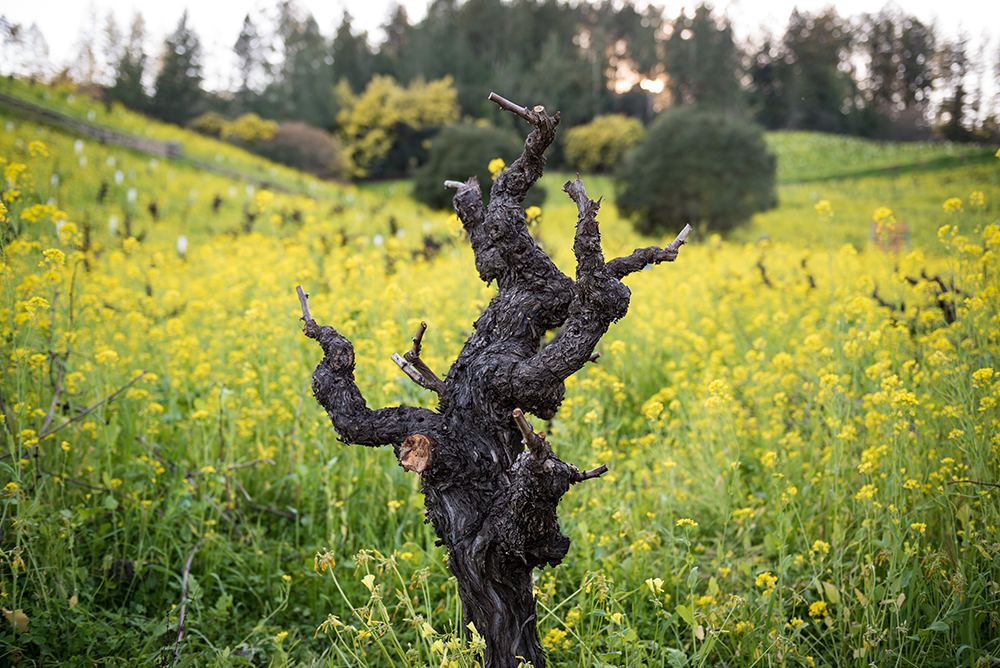
DRY
CREEK
VINEYARD OLD VINE ZINFANDEL 2016
($35)—So much California Zin is dank or
sweet, and too high in alcohol, but at its best,
especially when made from old
vines, it shows a spirit and texture few other
wines can match. Dry Creek of
Sonoma has championed the grape since the 1980s,
using old vines (right) when others were
ripping the
vines out, and they have created a paragon of a
rich, deeply fruited, complex
wine at 14.5% alcohol that is perfect with pig
in any form.
ROCCA
SVEVA
AMARONE DELLA VALPOLICELLA RISERVA 2013
($60)—It’s hard to find
old-style, leathery Amarones any more, unless they
date back to the 1980s, but
technology has made the wines far more stylish and
easier to drink with more
foods. At 15% alcohol this wine is also lower than
many others, so you get a
lush, powerful wine without the headaches. With
baby lamb or suckling pig,
you’ve got a blissful match.
❖❖❖
 AND NO PORKY PIG
IMAGES WITH HIS
AND NO PORKY PIG
IMAGES WITH HIS PANTS OFF!!
Facebook refused to run an image from King Cake Snob of the plastic baby figure placed inside King Cakes at Mardi Gras because, “This ad isn’t running because it includes an image or video depicting excessive skin or nudity, which includes medical diagrams depicting external organs of reproduction, breasts or butt. This kind of material is sensitive in nature.” King thereupon clothed the baby on their site.
HMMMM, IS THAT A HANGER STEAK LURKING IN THE LARDER?

“The baking by Rucker and her team
weaves one narrative.
The eclectic menus overseen by chef Shawn Pham tell
another tale. He leaps from
biscuits and gravy to an array of toast (but, pointedly,
no avocado toast) at
breakfast; tuna salad sandwich and a ginger-laced
chicken and cabbage salad for
lunch; and hamachi crudo,persimmon
and burrata salad and hanger
steak with Taleggio for
dinner. How these two storylines interlace is what gives
this restaurant its
persuasive, unexpected intrigue.”
Bill Addison, “Fiona showcases pie
queen Nicole Rucker’s baking talents,” LA Times (1/10/19).
Wine
Column Sponsored by Banfi Vintners
SANGIOVESE
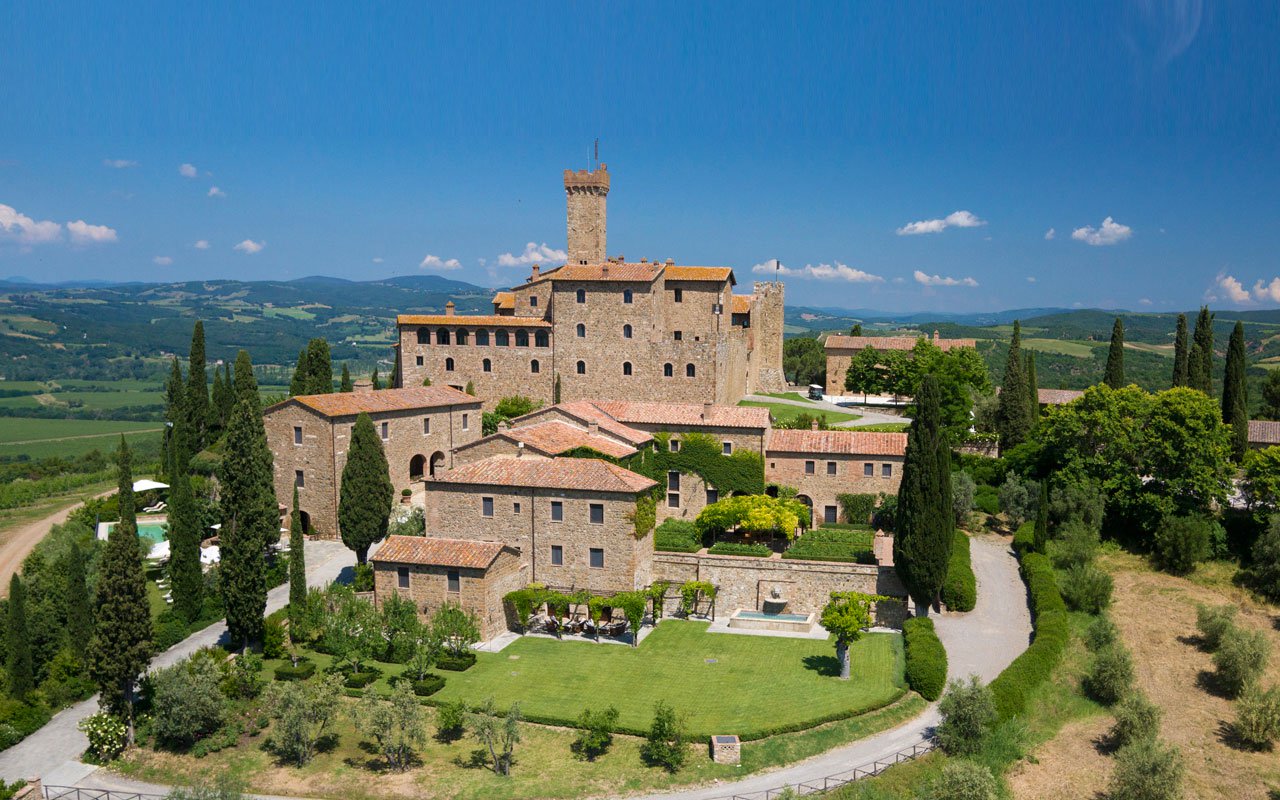 Wine is a joy year-round but
in cooler weather one
grape varietal has really taken center stage in
my daily activities – that most Italian of
grapes, Sangiovese, and its ultimate expression
– Brunello di Montalcino.
Wine is a joy year-round but
in cooler weather one
grape varietal has really taken center stage in
my daily activities – that most Italian of
grapes, Sangiovese, and its ultimate expression
– Brunello di Montalcino.
From mid-September through mid-October,
the Sangiovese grown for our various styles of red
wines are be harvested, culminating with the top
selection for Brunello di Montalcino.
Second, cooler weather here means
it is time to start enjoying more red wines and
especially Sangiovese based wines. That
includes Banfi’s cru of Brunello, Poggio alle Mura,
literally the cream of the crop of our Sangiovese
vineyards. Alongside our Poggio alle Mura Brunello di
Montalcino, this year we introduced two more wines
from the cru Poggio alle Mura – a Rosso di Montalcino
and a Riserva of Brunello. Rosso is sort of like the
younger brother of Brunello, also made from 100%
Sangiovese grapes but usually a selection from younger
vines and the wine is aged only two years compared to
the four required for Brunello. The
Riserva, on the other hand, is an even more selective
harvest of Sangiovese, and ages for an additional year
before release.
What is so special about this cru
Poggio alle Mura?
Well, it is the result our over 30 years of
ongoing research at my family’s vineyard estate,
Castello Banfi.
When we first began planting our vines there in
the late 1970s studies from the University of Bordeaux
indicated which strains of many varietals we should
plant, based on the soil type and microclimate of each
vineyard. But
when it came to the region’s native Sangiovese, there
was only local lore, no scientific research. So we took
it upon ourselves to figure out this vine, and set off
on three decades of incredibly detailed research.
We started
with 600 apparent variations on Sangiovese, because it
is so susceptible to variations in weather and soil,
and narrowed that down to 160 truly genetically
different clones.
We planted a vineyard with two rows of each
type, made wine from each of them, and charted the
differences – remember, you only get one chance a year
to make wine, so this took time.
It took about ten years to get some
concrete results, though we continue to experiment
today and always will – you never stop learning in
science and nature!
Once we determined which were the best,
complementary clones that could be planted together to
make the best Brunello, we chose to plant them in what
we determined to be the optimal vineyard sites. Coincidentally,
the best soils and climate conditions are in the
slopes surrounding the medieval fortress today known
as Castello Banfi, known since Etruscan times as
Poggio alle Mura – the walled hilltop. Hence the
name of our most special “cru” of Brunello,
representing a synthesis between tradition and
innovation.
Though the focus of this study was
our Brunello, all of our Sangiovese-based wines,
including the super Tuscans SummuS, Cum Laude, and
Centine, benefitted from this work. And that’s
the third reason for celebrating Sangiovese this
month, for the range of wonderful reds that usher us
into autumn! One
wine in particular was inspired by our research – the
BelnerO, a Sangiovese dominant blend with what I like
to call a kiss of Cabernet and a whisper of Merlot. We grow the
grapes a little differently for BelnerO than for
Brunello, make the wine with less oak aging and
released it earlier from the winery, providing a
counterpoint to Brunello and a lovely terroir-driven
wine in its own right.
If you
know Italians, you know that by nature we are
multi-faceted, varying in mood, and always passionate. As a
nation, we span from the hot sunny beaches of Sicily
near the African coast to the rugged mountains and
Alpine ski slopes of Trentino-Alto Adige in the north. Sangiovese
is grown in almost all of Italy’s regions and reflects
the unique nature of each; it is most famous
(rightfully so) in Tuscany, yet even there it reflects
the nuances of each hilltop, valley and subzone. It has
something a little different to say in Brunello than
Chianti, Morellino than Vino Nobile di Montepulciano,
Rosso di Montalcino than Super Tuscan blends.
Here is a smattering of
Sangiovese-based wines that you may wish to get to
know better, reflecting a spectrum that appeals to
every occasion, every taste, and every budget. We can
assure you that the conversation will never become
boring. 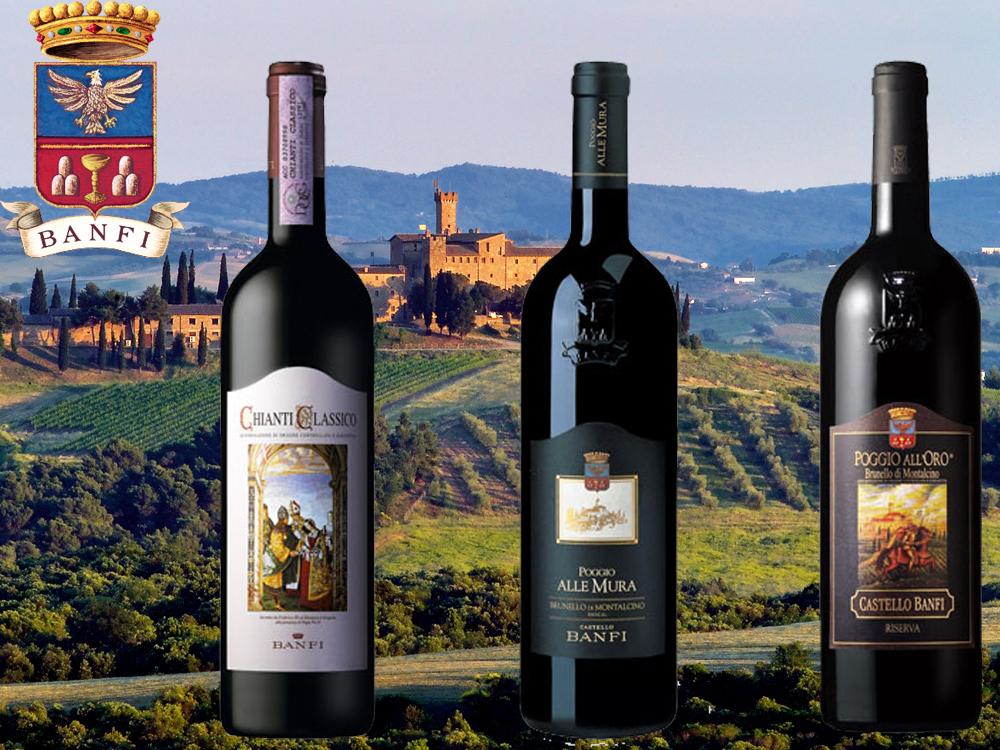
Recommendations for Celebrating
Sangiovese
BelnerO Proprietor’s Reserve Sangiovese
– A refined
cuvée of noble red grapes perfected by our pioneering
clonal research. This dark beauty, BelnerO, is
produced at our innovative winery, chosen 11
consecutive years as Italy’s Premier Vineyard Estate.
Fermented in our patented temperature controlled
French oak and aged approximately 2 additional years.
Unfiltered, and Nitrogen bottled to minimize sulfites.
Castello Banfi Brunello di Montalcino –
Rich, round, velvety and intensely
aromatic, with flavor hints of licorice, cherry, and
spices. Brunello di Montalcino possesses an intense
ruby-red color, and a depth, complexity and opulence
that is softened by an elegant, lingering aftertaste.
Unfiltered after 1998 vintage.
Castello Banfi Rosso di Montalcino – Brunello's "younger brother," produced
from select Sangiovese grapes and aged in barrique for
10 to 12 months. Deep ruby-red, elegant, vibrant,
well-balanced and stylish with a dry velvety
finish.
Poggio all’Oro Brunello di Montalcino
Riserva – A single vineyard selection of our most
historically outstanding Sangiovese, aged five years
before release, the additional year more than that
required of Brunello including 6 months in barrel and
6 months more in bottle to grant its “Riserva”
designation. Incredible
elegance and harmony. Intense with lots of fruit and
subtle wood influence. Round, complete, well balanced
with hints of chocolate and berries. Unfiltered after
1998.
Poggio alle Mura – The first tangible result of years of
intensive clonal research on Montalcino’s native
Sangiovese grape.
Estate bottled from the splendidly sun drenched
vineyards surrounding the medieval Castello from which
it takes its name.
The Brunello
di Montalcino is seductive, silky and smoky. Deep ruby
in color with an expressive bouquet of violets, fruits
and berries as well as cigar box, cedar and exotic
spices. The Rosso
di Montalcino is also intense ruby red. The bouquet
is fresh and fruity with typical varietal notes of
cherry and blackberry, enriched by more complex hints
of licorice, tobacco and hazelnut. It is full
bodied, yet with a soft structure, and a surprisingly
long finish. The Poggio alle Mura Brunello di Montalcino
Riserva is deep ruby red with garnet
reflections and a rich, ample bouquet that hints of
prune jam, coffee, cacao and a light balsamic note. It is full
and powerful, with ripe and gentle tannins that make
it velvety and harmonious; this wine is supported by a
pleasing minerality that to me speaks soundly of that
special hillside in southern Montalcino.
SummuS – A wine of towering elegance, SummuS is an
extraordinary blend of Sangiovese which contributes
body; Cabernet Sauvignon for fruit and structure; and
Syrah for elegance, character and a fruity bouquet. An elegant,
complex and harmonious red wine.
Cum Laude – A complex and elegant red which graduated
“With Honors,” characterized by aromas of juicy
berries and fresh spices.
Centine – A Cuvee that is more than half
Sangiovese, the balanced consisting of equal parts of
Cabernet Sauvignon and Merlot. Vinified in
a firm, round style that easily accompanies a wide
range of dishes, this is a smooth and fragrantly
satisfying wine with international character, and a
perennial favorite at my own dinner table.
Banfi Chianti Superiore – The “Superiore” designation signifies
stricter government regulations regarding production
and aging requirements, as compared to regular
Chianti. An
intense ruby red wine with fruit forward aromas and
floral notes. This
is a round wine with well-balanced acidity and fruit.
Banfi Chianti Classico – An enduring classic: alluring
bouquet of black fruit and violets; rich flavors of
cherry and leather; supple tannins and good acidity
for dining.
Banfi Chianti Classico Riserva – Produced from select grapes grown in the
"Classico" region of Chianti, this dry, fruity and
well-balanced red has a full bouquet reminiscent of
violets.
Fonte alla Selva Chianti Classico – This is our newest entry into the Chianti
arena, coming from a 99 acre estate in Castellina, the
heart of the Chianti Classico region. The wine is
a captivating mauve red that smells of cherry, plum
and blackberry with hints of spice. It is
round, full and balanced with very good
acidity.
Col di Sasso – Sangiovese and Cabernet Sauvignon. Luscious,
complex and soft with persistent notes of fruit and
great Italian style structure.
Any of John Mariani's books below may be ordered from amazon.com.
 The Hound in Heaven
(21st Century Lion Books) is a novella, and
for anyone who loves dogs, Christmas, romance,
inspiration, even the supernatural, I hope you'll find
this to be a treasured favorite. The story
concerns how, after a New England teacher, his wife and
their two daughters adopt a stray puppy found in their
barn in northern Maine, their lives seem full of promise.
But when tragedy strikes, their wonderful dog Lazarus and
the spirit of Christmas are the only things that may bring
his master back from the edge of despair.
The Hound in Heaven
(21st Century Lion Books) is a novella, and
for anyone who loves dogs, Christmas, romance,
inspiration, even the supernatural, I hope you'll find
this to be a treasured favorite. The story
concerns how, after a New England teacher, his wife and
their two daughters adopt a stray puppy found in their
barn in northern Maine, their lives seem full of promise.
But when tragedy strikes, their wonderful dog Lazarus and
the spirit of Christmas are the only things that may bring
his master back from the edge of despair. WATCH THE VIDEO!
“What a huge surprise turn this story took! I was completely stunned! I truly enjoyed this book and its message.” – Actress Ali MacGraw
“He had me at Page One. The amount of heart, human insight, soul searching, and deft literary strength that John Mariani pours into this airtight novella is vertigo-inducing. Perhaps ‘wow’ would be the best comment.” – James Dalessandro, author of Bohemian Heart and 1906.
“John Mariani’s Hound in Heaven starts with a well-painted portrayal of an American family, along with the requisite dog. A surprise event flips the action of the novel and captures us for a voyage leading to a hopeful and heart-warming message. A page turning, one sitting read, it’s the perfect antidote for the winter and promotion of holiday celebration.” – Ann Pearlman, author of The Christmas Cookie Club and A Gift for my Sister.
“John Mariani’s concise, achingly beautiful novella pulls a literary rabbit out of a hat – a mash-up of the cosmic and the intimate, the tragic and the heart-warming – a Christmas tale for all ages, and all faiths. Read it to your children, read it to yourself… but read it. Early and often. Highly recommended.” – Jay Bonansinga, New York Times bestselling author of Pinkerton’s War, The Sinking of The Eastland, and The Walking Dead: The Road To Woodbury.
“Amazing things happen when you open your heart to an animal. The Hound in Heaven delivers a powerful story of healing that is forged in the spiritual relationship between a man and his best friend. The book brings a message of hope that can enrich our images of family, love, and loss.” – Dr. Barbara Royal, author of The Royal Treatment.
 |
The Encyclopedia of American Food and Drink by John F. Mariani (Bloomsbury USA, $35) Modesty forbids me to praise my own new book, but let me proudly say that it is an extensive revision of the 4th edition that appeared more than a decade ago, before locavores, molecular cuisine, modernist cuisine, the Food Network and so much more, now included. Word origins have been completely updated, as have per capita consumption and production stats. Most important, for the first time since publication in the 1980s, the book includes more than 100 biographies of Americans who have changed the way we cook, eat and drink -- from Fannie Farmer and Julia Child to Robert Mondavi and Thomas Keller. "This book is amazing! It has entries for everything from `abalone' to `zwieback,' plus more than 500 recipes for classic American dishes and drinks."--Devra First, The Boston Globe. "Much needed in any kitchen library."--Bon Appetit. |
"Eating Italian will never be the same after reading John Mariani's entertaining and savory gastronomical history of the cuisine of Italy and how it won over appetites worldwide. . . . This book is such a tasteful narrative that it will literally make you hungry for Italian food and arouse your appetite for gastronomical history."--Don Oldenburg, USA Today. "Italian
restaurants--some good, some glitzy--far
outnumber their French rivals. Many of
these establishments are zestfully described
in How Italian Food Conquered the World, an
entertaining and fact-filled chronicle by
food-and-wine correspondent John F.
Mariani."--Aram Bakshian Jr., Wall Street
Journal.
"Equal parts
history, sociology, gastronomy, and just
plain fun, How Italian Food Conquered the
World tells the captivating and delicious
story of the (let's face it) everybody's
favorite cuisine with clarity, verve and
more than one surprise."--Colman Andrews,
editorial director of The Daily
Meal.com. "A fantastic and fascinating
read, covering everything from the influence
of Venice's spice trade to the impact of
Italian immigrants in America and the
evolution of alta cucina. This book will
serve as a terrific resource to anyone
interested in the real story of Italian
food."--Mary Ann Esposito, host of PBS-TV's
Ciao
Italia. "John Mariani has written the
definitive history of how Italians won their
way into our hearts, minds, and
stomachs. It's a story of pleasure over
pomp and taste over technique."--Danny Meyer,
owner of NYC restaurants Union Square
Cafe, The Modern, and Maialino.
|
 |
 |
 |
 |
 |
 |
 |
 |
 Everett Potter's Travel Report:
Everett Potter's Travel Report: 
 Eating Las Vegas
JOHN CURTAS has been covering the Las Vegas
food and restaurant scene since 1995. He is
the co-author of EATING LAS VEGAS – The 50
Essential Restaurants (as well as
the author of the Eating Las Vegas web site: www.eatinglasvegas.
He can also be seen every Friday morning as
the “resident foodie” for Wake Up With the
Wagners on KSNV TV (NBC) Channel 3 in
Las Vegas.
Eating Las Vegas
JOHN CURTAS has been covering the Las Vegas
food and restaurant scene since 1995. He is
the co-author of EATING LAS VEGAS – The 50
Essential Restaurants (as well as
the author of the Eating Las Vegas web site: www.eatinglasvegas.
He can also be seen every Friday morning as
the “resident foodie” for Wake Up With the
Wagners on KSNV TV (NBC) Channel 3 in
Las Vegas.
MARIANI'S VIRTUAL GOURMET
NEWSLETTER is published weekly. Publisher: John Mariani. Editor: Walter Bagley. Contributing Writers: Christopher Mariani,
Robert Mariani, Misha Mariani, John A. Curtas, Gerry Dawes, Geoff Kalish,
and Brian Freedman. Contributing
Photographer: Galina Dargery. Technical
Advisor: Gerry
McLoughlin.
If you wish to subscribe to this
newsletter, please click here: http://www.johnmariani.com/subscribe/index.html
© copyright John Mariani 2019

